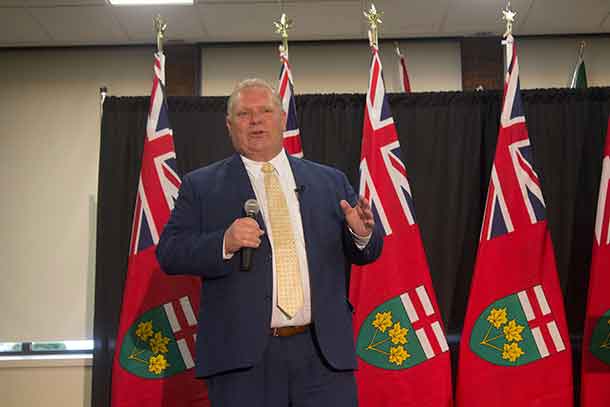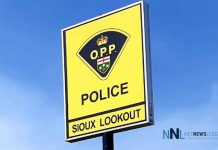TORONTO — “During these unprecedented times, our government is prepared for any scenario, and that includes the spring flooding season,” said Premier Ford.
 “By working together with our federal, municipal, and First Nations partners and putting our provincial flooding strategy into action, we have taken the critical steps needed to help keep people and communities safe.” The Ontario government has been actively working with federal and municipal governments, First Nations partners and non-governmental organizations to prepare and respond to any flooding situation across the province during the COVID-19 outbreak. As part of Ontario’s flood preparedness planning, the province has been working with the federal government, municipalities and First Nations partners to develop evacuation plans. Recognizing the impact of COVID-19 on municipalities this year, Ontario is taking the lead on identifying suitable locations to host evacuees and to minimize the reliance on municipal resources for various supports, including health care and social services. As a result, the province has taken steps to ensure that provincial, federal and non-governmental resources, such as the Canadian Red Cross, can be deployed to minimize the burden on local communities as much as possible. Respecting Indigenous Traditions During COVID-19Ontario has a fire ban in effect during the COVID-19 pandemic. For Indigenous people, a sacred fire is one of the key components for grieving and healing following the passing of a loved one. Minister John Yakabuski advises that for a sacred fire, all the Ministry would ask is that they are notified, and that ministry officials are aware that those calls will be coming in. The provincial fire ban is in effect and many cities have also instituted fire bans. However from Minister Yakabuski, for Indigenous people, there is an exemption for sacred fires for ceremonial purposes. A sacred fire is an Indigenous traditional wellness approach. The fire is one of the ways to start a ceremony or any sacred event. It is a spiritual doorway that opens to a spiritual realm so that individuals can communicate and have relations through the fire. It also used to connect with the ancestors, the ones who have gone on before. People put tobacco in the fire and acknowledge their ancestors and request prayers. People are only allowed to put sacred items (tobacco, sage, cedar, sweetgrass) and/or food into the fire. The sacred fire is never left alone, it is watched and attended to by a Fire Keeper. Flooding ConcernsThe flooding update was provided today by Premier Doug Ford, John Yakabuski, Minister of Natural Resources and Forestry, Sylvia Jones, Solicitor General, and Christine Elliott, Deputy Premier and Minister of Health. Ontario has also been engaging with the federal government to support First Nations communities staying on their lands as long as it is safe to do so, including where First Nations community members would be temporarily relocated to higher and safer grounds within their own communities. Relocating community members from reserve to traditional hunt camps or other remote sites also addresses concerns around the potential spread of COVID-19 to these vulnerable communities. “Our staff are closely monitoring ongoing flooding risks across the province and working with partners and communities on any areas of concern,” said Minister Yakabuski. “We are ready to respond to any requests for sandbags during this very challenging time. We also continue to work with our partners to advance the important long-term initiatives outlined in Ontario’s Flooding Strategy, which will help us become more resilient to flooding events in the years to come.” Current provincial projections show a moderate-to-high risk of flooding for northern Ontario and the James and Hudson Bay coasts, where staff are closely monitoring all major tributaries in anticipation of ice breakup, expected to begin in early May. As of April 30, 2020, surveillance flights have begun across the Far North to monitor these ice breakups, with operations based out of the Ministry of Natural Resources and Forestry’s Moosonee Field Office. There is also a risk of shoreline flooding from snowmelt in southern Ontario along the Great Lakes. The province’s Surface Water Monitoring Centre in Peterborough continues to monitor water levels in other areas at risk throughout the province, including communities in the Ottawa Valley and along the Great Lakes. “Thanks to the extraordinary efforts of our emergency management personnel and partners, we will be able to safely evacuate Northern communities and provide for their needs until they can safely return home,” said Solicitor General Jones. “We continue to monitor flood risks and we are assessing all necessary actions to maintain the safety and wellbeing of communities. We will be ready to proceed with evacuations should the need arise.” “Our government will continue to work with First Nations leadership and the federal government to ensure the safety of remote Indigenous community members during the flood season,” said Greg Rickford, Minister of Indigenous Affairs. “If or when an evacuation occurs, it will be conducted in the safest way possible, providing additional support to evacuees and northern host communities. Indigenous leaders across the province have taken critical steps to protecting their communities from the spread of COVID-19 and we will continue to support those efforts throughout the flooding season.” In March, the government released Protecting People and Property: Ontario’s Flooding Strategy, which outlines the steps the province is taking to reduce flood risks and help Ontarians better prepare for flooding events. Actions outlined in the strategy include increasing access to current and timely information, using improved future rainfall prediction data and establishing a flood mapping technical team. |
QUICK FACTS
|







